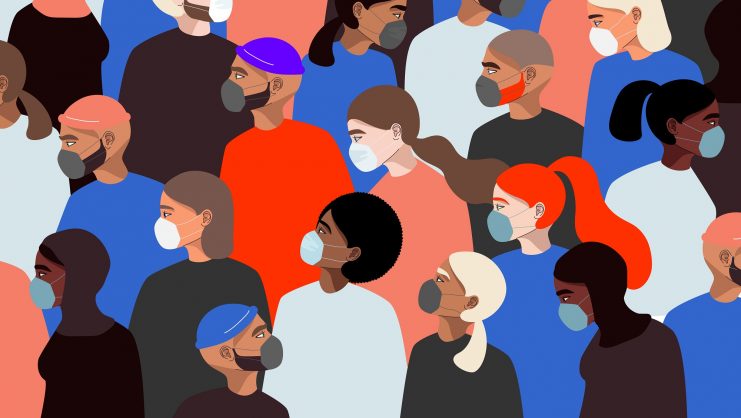As a historian who has studied Iraq’s biological weapons program of the 1980s, I have also examined the history of germs – bacteria like Anthrax and viruses, such as smallpox. My conclusion is that, if these germs were to be weaponized, as was attempted by the US and USSR during the Cold War, the greatest impact on a society would not come from the biological outbreak itself. Rather, the societal fear that would spread in the aftermath – the terrorization process of such biological agents – would be just as lethal, if not more so, than the weaponized pathogen.
The outbreak of COVID-19 functions like a terrorist attack, leading to widespread fear that obscures reality. In 2014, for example, the emergence of both ISIS and Ebola resulted in xenophobia against a scapegoated ethnic or religious group with states obsessing over their sovereignty and borders in the face of a transnational threat. Likewise, both ISIS and coronavirus led the Trump administration to issue travel bans to the US.
Even the head of the World Health Organization (WHO) has warned that the coronavirus outbreak has consequences greater “than any terrorist attack.” Fear is central to both phenomena: much like a terrorist attack, viruses go viral thanks to the media. Terrorists seek to innovate their tactics of terror, and COVID-19 is a new disease, or “novel,” of coronavirus. The 24-hour news cycles and cyberspace amplify their presence. Indeed, while both pose a threat, both are projected as existential risks, when in fact humanity is in a constant state of living with quotidian, banal, and mundane threats ranging from heart disease to car accidents.
The outbreak of a virus among a human population is a natural phenomenon that has occurred over millennia. What is novel about this particular outbreak is its ability to transform the condition of modernity in the 21st century. Unlike the Black Death of the mid-14th century for example, the ensuing fear has led to financial systems collapsing in an age of global supply chains. The end of the 20th century led to borders opening when the cold war ended only to see the closed in response to the virus. Finally, fear has led to xenophobic nationalism that targeted those of Asian descent in the West, or a callous disregard for the well-being of the elderly in some states.
In addition to the aforementioned socio-economic disruptions, the coronavirus that emerged in Wuhan serves as a reminder that diseases are not just biological but political – or in this case, geopolitical. The impact of COVD-19 in Wuhan, and the resulting spread, was exacerbated by tension between China and other nations, particularly in regards to the country’s resurgent naval power, 5G mobile, and trade relations. On the national level in China, COVID-19 challenges public health governance of an epidemic. On the international level, with the epidemic around Wuhan becoming a pandemic, it has forced other nations to react. Entire regional systems, from the EU to the regional cold war in the Middle East, have been impacted. The EU’s premise of open borders and markets has been challenged by the pandemic, while sectarian tensions in the Middle East have been inflamed by scapegoating Shi’a Muslims who spread the disease in the region after visiting pilgrimage sites in Iran.
On the levels of non-state actors, media – both traditional and social – has spread fear and xenophobia, with politicians from the US, China, Russia, and Iran going on the air to claim the virus is a man-made biological weapon, using viral memes to spread this myth and blaming its existence on the likes of the Gates Foundation to the Illuminati.
As a result, the coronavirus crisis has resulted in the confluence of xenophobic nationalist myths and the proliferation of medical myths, which have compelled multilateral organizations like the WHO to develop policies to fight misinformation and viral memes with their own memes debunking theories about how 5G cell towers caused the outbreak or that garlic can prevent infection. Based on the WHO’s ability to post information on sites such as YouTube and Instagram, the organization is able to reach a global audience via unprecedented digital communication strategies.
Finally, there is the global climatic level. Like our modern-day environmental challenges, viruses do not have ethnic, racial, or national constraints. While the disease may have surfaced in China, the coronavirus is a problem that is global in nature and is the result of humankind exploiting jungles and forests where viruses live amongst the wildlife and make the jump to human hosts. Thus, international policies designed to contain disease must also relate to policies – policies yet to be developed – regarding climate change.
Diseases result from the ways in which we humans interact with the environment. It is paramount that we mitigate this interface in order to prevent future outbreaks. Secondly, increased medical education is needed to fight disinformation and better prepare for the next, yes the next, outbreak.
The international policies needed to check climate change are the same that we will need to manage transnational pathogens and they will require cooperation on the multinational, national, and local levels, based on the free flow of accurate scientific information.






